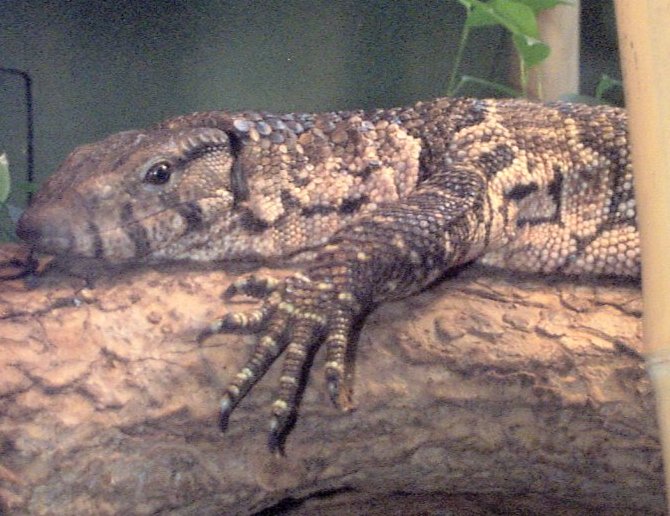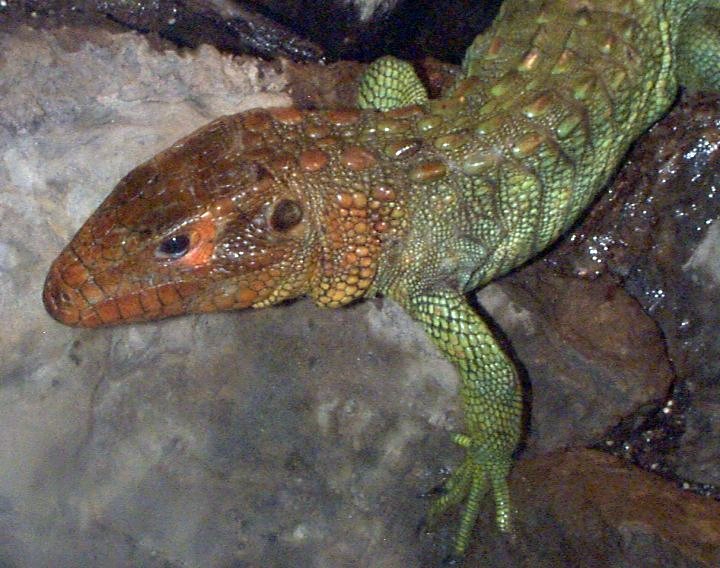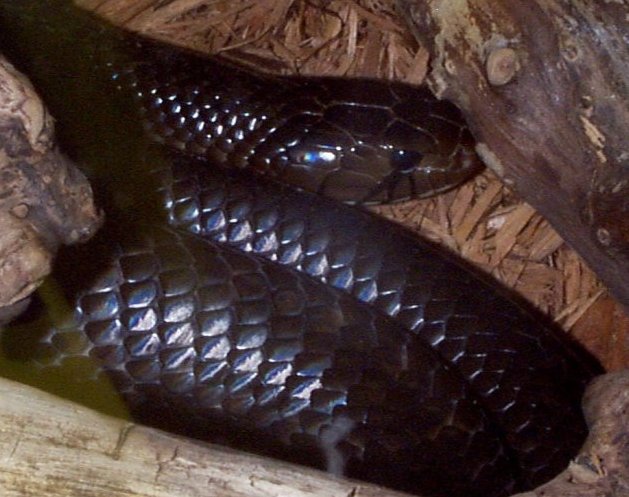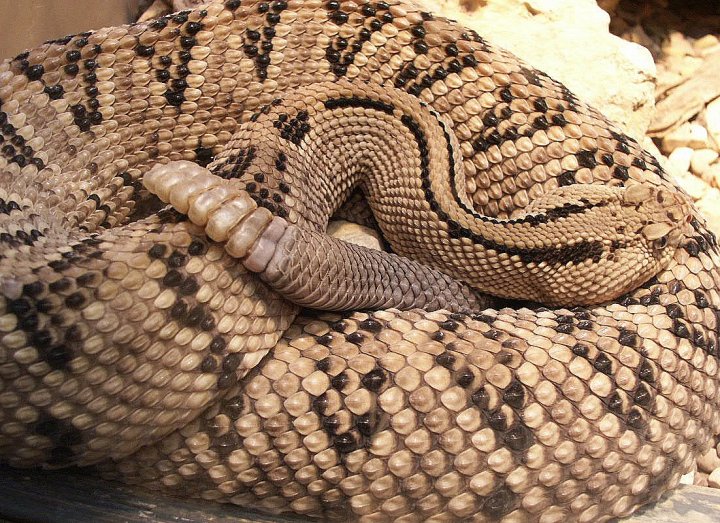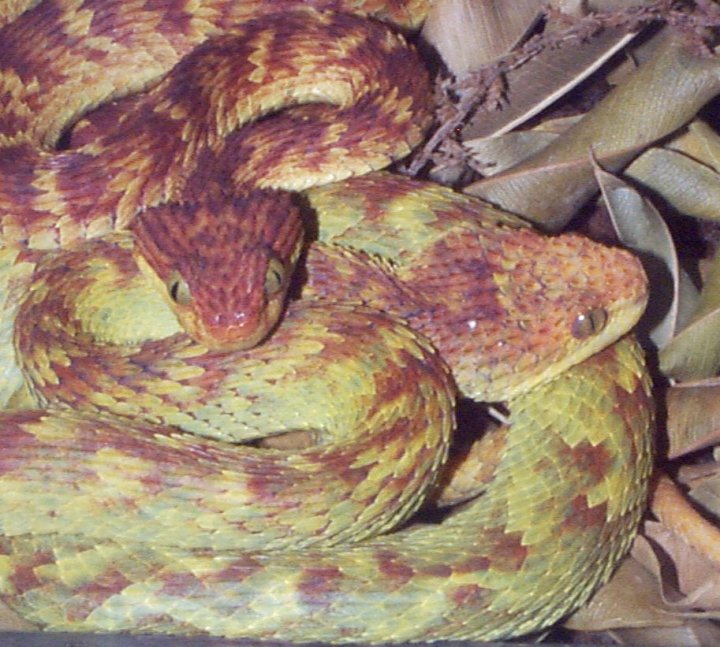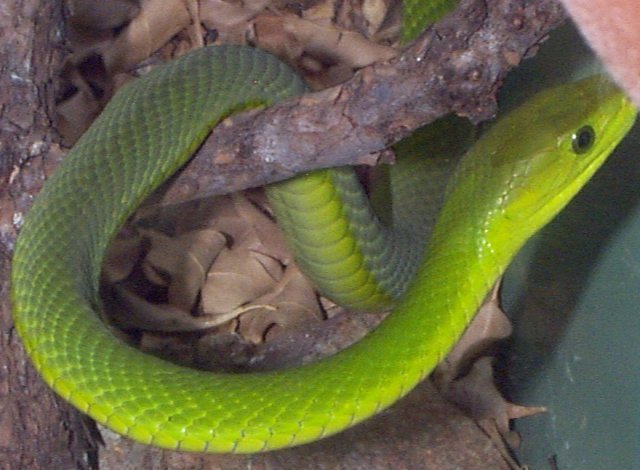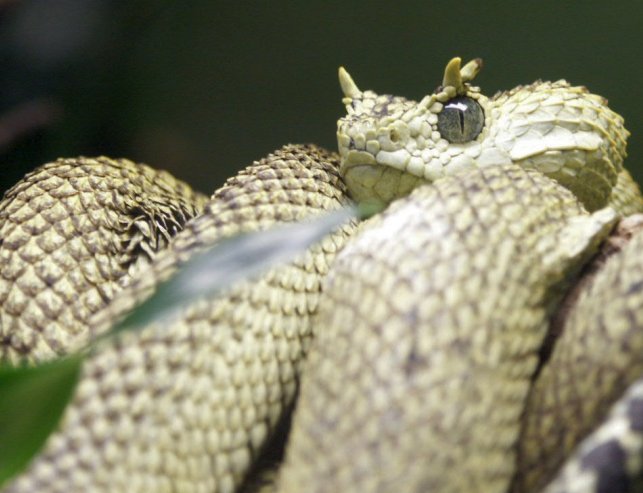Scales in Lizards:
In some lizards, the scales are small, fairly uniform and arranged in highly organized patterns. In geckos, like the Standing's day gecko below, the scales are soft and delicate, and the skin may easily tear. In geckos, specialized scales on the foot are subdivided into rows of branched microscopic flaps that adhere very closely to smooth surfaces, enabling geckos to walk up glass.
Monitors also have small regular scales, but much tougher than those found in geckos. Some scales in monitors are underlain by small dermal bones similar to those found in the scales of turtles and crocodiles. In the Dumeril's monitor below, you can see the scale arrangement typical of the monitor lizards. How does this scale pattern compare to that of the Komodo dragon? Compare these monitors' scales to those of this Mexican beaded lizard, to which they are related. What similarities and differences do you see?
Not all lizards have uniform scales. Look
at the Caiman lizard and the Panther chameleon in the pictures below.
both lizards have scales of different sizes over the head and body. Compare
the arrangement of these different sized scales in the Caiman lizard and
in the chameleon. Note the rings of scales around the eyes and the ridges
of spiky scales on the head and down the back of the chameleon. |
|
|
Iguanids are known for the variety of their scales, but note that the body scales are fairly uniform and arranged in neat rows. Much of the variation is seen in the scales on the head and down the back. Compare the head and neck scales of the Green iguana below with its body scales. In the Spiny tail lizard, the fancy scales are not on the head, but on its opposite end. look at the tail and hind legs of this lizard. What do you suppose this lizard does with the spines on its tail? |
|
Scales in Snakes:
The two general types of scales found in snakes are smooth scales, which are shiny and reflective, and keeled scales, which have one or more ridges down the central axis of the scale, and which are rougher. Compare the smooth scales of the Indigo snake below with the keeled scales of the Northwest neotropical rattlesnake. Microscopically, smooth scales have densely packed parallel fibers or ridges, while keeled scales look more like ladders, with stout widely spaced ridges cross-connected by fibers running at right angles to the ridges. Click here for photos of the microscopic structure of some smooth and keeled scales. Smooth snakes are frequently iridescent due to parallel ridges that make a diffraction surface, as in this Boelen's python. In some snakes with keeled scales, the scales flare up at the ends to give the snake an almost feathery appearance, as in the Lowland bush viper seen below. The significance of the rough vs. smooth scale is obscure. There seems to be no particular correlation with life style, and even closely related species may have different types of scale. It may be the snake equivalent of having straight or curly hair. Smith, et al. have suggested that the ridges on snake scales may serve to hold pheromones produced by cloacal scent glands.
The body scales of snakes are closely packed, overlapping and organized into diagonal rows. Compare the arrangement of the scales on the snakes below with those of the lizards above. The ventral (belly) body scales of snakes are broader than those on the snake's back. Compare the size of the back and belly scales of the green mamba (also seen below) and of Boelen's python. The belly scales are attached to the ribs by muscles, so snakes can glide in a straight line by moving the scales back and forth over the ribs. Decorative scales occur on the heads of some snakes. These specialized scales are found near the eyes as "eyelashes" or near the nose as "horns" (see below). Decorative scales usually come in pairs, but the Vietnamese leafnosed snake has a single "horn" at the end of its nose. The tentacled snake has nasal projections that serve as a lure to attract the fish it eats. What might the function of other specialized head scales be? |
|
|
|
|
One important group of snakes has specialized scales on the tail. As the snake sheds, the old scales are kept rather than falling off. What kind of snake is this and what is the function of the scales?
On a cold or rainy day, you can spend a very pleasant afternoon in the Herpetarium of the Fort Worth Zoo looking at the different types of scales found in reptiles. If you discover a specialized type of scale that you think should be added to this ZooPax, E-mail zoopax@whozoo.org. If your scale suggestion is used, we will give you and your school a credit and identify your contribution.

